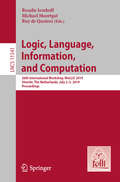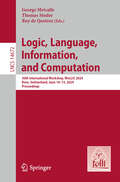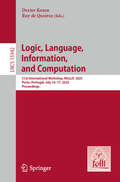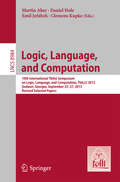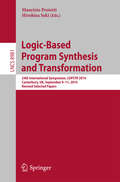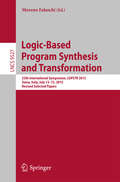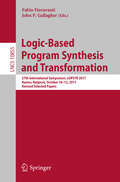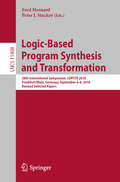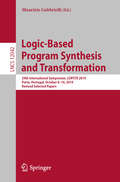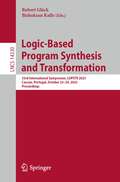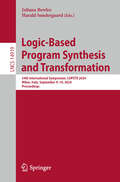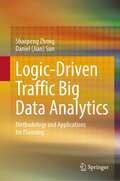- Table View
- List View
Logic, Language, Information, and Computation: 26th International Workshop, WoLLIC 2019, Utrecht, The Netherlands, July 2-5, 2019, Proceedings (Lecture Notes in Computer Science #11541)
by Ruy De Queiroz Rosalie Iemhoff Michael MoortgatEdited in collaboration with FoLLI, the Association of Logic, Language and Information this book constitutes the refereed proceedings of the 26th Workshop on Logic, Language, Information and Communication, WoLLIC 2019, held in Utrecht, The Netherlands, in July 2019. The 41 full papers together with 6 invited lectures presented were fully reviewed and selected from 60 submissions. The idea is to have a forum which is large enough in the number of possible interactions between logic and the sciences related to information and computation, and yet is small enough to allow for concrete and useful interaction among participants.
Logic, Language, Information, and Computation: 28th International Workshop, WoLLIC 2022, Iași, Romania, September 20–23, 2022, Proceedings (Lecture Notes in Computer Science #13468)
by Agata Ciabattoni Elaine Pimentel Ruy J. G. B. de QueirozEdited in collaboration with FoLLI, the Association of Logic, Language and Information this book constitutes the refereed proceedings of the 28th Workshop on Logic, Language, Information and Computation, WoLLIC 2022, Iasi, Romania, in September 2022. The 25 full papers presented included with 8 extra abstracts, 5 invited talks and 3 tutorials were fully reviewed and selected from 46 submissions. The conference aims fostering interdisciplinary research in pure and applied logic.
Logic, Language, Information, and Computation: 30th International Workshop, WoLLIC 2024, Bern, Switzerland, June 10–13, 2024, Proceedings (Lecture Notes in Computer Science #14672)
by Thomas Studer Ruy De Queiroz George MetcalfeEdited in collaboration with FoLLI, the Association of Logic, Language and Information this book constitutes the refereed proceedings of the 30th International Workshop on Logic, Language, Information, and Computation, WoLLIC 2024, held in Bern, Switzerland, during June 10–13, 2024. The 18 full papers included in this book were carefully reviewed and selected from 37 submissions. This book also contains six invited abstracts. The WoLLIC conference series aims at fostering interdisciplinary research in pure and applied logic.
Logic, Language, Information, and Computation: 31st International Workshop, WoLLIC 2025, Porto, Portugal, July 14–17, 2025, Proceedings (Lecture Notes in Computer Science #15942)
by Ruy De Queiroz Dexter KozenEdited in collaboration with FoLLI, the Association of Logic, Language and Information this book constitutes the refereed proceedings of the 31st International Workshop on Logic, Language, Information, and Computation, WoLLIC 2025, in Porto, Portugal, during July 2025. The 21 full papers included in this book were carefully reviewed and selected from 57 submissions. The WoLLIC conference aim of fostering interdisciplinary research in pure and applied logic.
Logic, Language, and Computation
by Martin Aher Daniel Hole Emil Jeřábek Clemens KupkeThis book constitutes the refereed proceedings of the 10th International Tbilisi Symposium on Logic, Language and Computation, TbiLLC 2013, held in Gudauri, Georgia, in September 2013. The conference series is centered around the interaction between logic, language and computation. The contributions represent these three fields and the symposia aim to foster interaction between them. The book consists of 16 papers that were carefully reviewed and selected from 26 submissions. Each paper has passed through a rigorous peer-review process before being accepted for publication. The volume also contains two summaries of the tutorials that took place at the symposium: the one on admissible rules and the one on the formal semantics of aspectual meaning from a cross-linguistic perspective.
Logic, Language, and Computation
by Henk Zeevat Helle Hvid Hansen Sarah E. Murray Mehrnoosh SadrzadehThis book constitutes the refereed proceedings of the 11th International Tbilisi Symposium on Logic, Language and Computation, TbiLLC 2015, held in Tbilisi, Georgia, in September 2015. Initially there were 64 submissions, but 29 were actually presented of which 18 full papers have been accepted. The biennial conference series and the proceedings are representative of the aims of the organizing institutes: to promote the integrated study of logic, information and language. The scientific program consisted of tutorials, invited lectures, contributed talks, and two workshops.
Logic, Language, and Security: Essays Dedicated to Andre Scedrov on the Occasion of His 65th Birthday (Lecture Notes in Computer Science #12300)
by Carolyn Talcott Vivek Nigam Tajana Ban Kirigin Joshua Guttman Stepan Kuznetsov Boon Thau Loo Mitsuhiro OkadaThis Festschrift was published in honor of Andre Scedrov on the occasion of his 65th birthday. The 11 technical papers and 3 short papers included in this volume show the many transformative discoveries made by Andre Scedrov in the areas of linear logic and structural proof theory; formal reasoning for networked systems; and foundations of information security emphasizing cryptographic protocols. These papers are authored by researchers around the world, including North America, Russia, Europe, and Japan, that have been directly or indirectly impacted by Andre Scedrov. The chapter “A Small Remark on Hilbert's Finitist View of Divisibility and Kanovich-Okada-Scedrov's Logical Analysis of Real-Time Systems” is available open access under a CC BY 4.0 license at link.springer.com.
Logic, Rationality, and Interaction: 10th International Conference on Logic, Rationality and Interaction, LORI 2025, Xi’an, China, October 16–19, 2025, Proceedings (Lecture Notes in Computer Science #16010)
by Wei Wang Valentin Goranko Chenwei ShiThis LNCS book is part of the FOLLI book series and constitutes the proceedings of the 10th International Conference on Logic, Rationality, and Interaction, LORI 2025, held in Xi&’an, China, in October 2025. The 14 full papers presented in this book were carefully reviewed and selected from 47 submissions.The topics addressed in this program effectively showcase the breadth and depth characteristic of the LORI conference series, including contributions on dynamic epistemic logic, nonmonotonic reasoning, belief revision theory, decision theory, causal inference, social epistemology and so on.
Logic, Rationality, and Interaction: 7th International Workshop, LORI 2019, Chongqing, China, October 18–21, 2019, Proceedings (Lecture Notes in Computer Science #11813)
by Patrick Blackburn Emiliano Lorini Meiyun GuoThis LNCS book is part of the FOLLI book series and constitutes the proceedings of the 7th International Workshop on Logic, Rationality, and Interaction, LORI 2019, held in Chongqing, China, in October 2019.The 31 papers presented in this book were carefully reviewed and selected from 56 submissions. They focus on the following topics: agency; argumentation and agreement; belief revision and belief merging; belief representation; cooperation; decision making and planning; natural language; philosophy and philosophical logic; and strategic reasoning.
Logic, Rationality, and Interaction: 9th International Workshop, LORI 2023, Jinan, China, October 26–29, 2023, Proceedings (Lecture Notes in Computer Science #14329)
by Andreas Herzig Natasha Alechina Fei LiangThis LNCS book is part of the FOLLI book series and constitutes the proceedings of the 9th International Workshop on Logic, Rationality, and Interaction, LORI 2023, held in Jinan, China, in October 2023.The 15 full papers presented together with 7 short papers in this book were carefully reviewed and selected from 40 submissions. The workshop covers a wide range on the following topics such as agency; argumentation and agreement; belief representation; probability and uncertainty; belief revision and belief merging; knowledge and action; dynamics of informational attitudes; intentions, plans, and goals; decision making and planning; preference and utility; cooperation; strategic reasoning and game theory; epistemology; social choice; social interaction; speech acts; knowledge representation; norms and normative systems; natural language; rationality; philosophical logic.
Logic, Rewriting, and Concurrency
by Peter Csaba Ölveczky Narciso Martí-Oliet Carolyn TalcottThis Festschrift volume contains 28 refereed papers including personal memories, essays, and regular research papers by close collaborators and friends of José Meseguer to honor him on the occasion of his 65th birthday. These papers were presented at a symposium at the University of Illinois at Urbana-Champaign on September 23-25, 2015. The symposium also featured invited talks by Claude and Hélène Kirchner and by Patrick Lincoln. The foreword of this volume adds a brief overview of some of José's many scientific achievements followed by a bibliography of papers written by José.
Logic, Syntax, and a Structural View: The Psychology of Trump's Hall of Mirrors
by Harwood FisherThis book presents a new structural approach to the psychology of the person, inspired by Kenneth Colby’s computer-generated simulation, PARRY. The simulation was of a paranoid psychological state, represented in forms of the person's logic and syntax, as these would be evidenced in personal communication. Harwood Fisher uses a Structural View to highlight similarities in the logical form of the linguistic representations of Donald Trump, his avid followers (“Trumpers”), and the paranoid—referred to as “The Trio.” He demonstrates how the Structural View forms a series of logical and schematic patterns, similar to the way that content analysis can bring forth associations meanings, and concepts held in the text. Such comparisons, Fisher argues, can be used to shed light on contingencies for presenting, representing, and judging truth. Specifically, Fisher posits that the major syntactic and logical patterns that were used to produce the computer-generated “paranoid” responses in Colby’s project can be used to analyze Donald Trump’s rhetoric and his followers’ reactions to it. Ultimately, Fisher offers a new kind of structural approach for the philosophy of psychology. This novel work will appeal to students and scholars of social and cognitive psychology, psychology of personality, psychiatric classification, psycholinguistics, rhetoric, and computer science.
Logic-Based Program Synthesis and Transformation
by Maurizio Proietti Hirohisa SekiThis book constitutes the thoroughly refereed post-conference proceedings of the 24th International Symposium on Logic-Based Program Synthesis and Transformation, LOPSTR 2014, held in Canterbury, UK, in September 2014. The 18 revised full papers presented together with 2 invited talks were carefully reviewed and selected from 34 submissions. The aim of the LOPSTR series is to stimulate and promote international research and collaboration on logic-based program development. The papers are organized along a set of thematic tracks: program analysis and transformation, constraint handling rules, termination analysis, security, program testing and verification, program synthesis, program derivation, semantic issues in logic programming and program transformation and optimization.
Logic-Based Program Synthesis and Transformation
by Moreno FalaschiThis book constitutes the thoroughly refereedpost-conference proceedings of the 25th International Symposium on Logic-BasedProgram Synthesis and Transformation, LOPSTR 2015, held in Siena, Italy, inJuly 2015. The 21 revised full papers presented together with 3invited talks were carefully reviewed and selected from 30 submissions. The aimof the LOPSTR series is to stimulate and promote international research andcollaboration on logic-based program development. LOPSTR is open tocontributions in all aspects of logic-based program development, all stages ofthe software life cycle, and issues of both programming-in-the-small andprogramming-in-the-large.
Logic-Based Program Synthesis and Transformation: 27th International Symposium, LOPSTR 2017, Namur, Belgium, October 10-12, 2017, Revised Selected Papers (Lecture Notes in Computer Science #10855)
by John P. Gallagher Fabio FioravantiThis book constitutes the thoroughly refereed post-conference proceedings of the 27th International Symposium on Logic-Based Program Synthesis and Transformation, LOPSTR 2017, held in Namur, Belgium, in October 2017. The 19 revised full papers were carefully reviewed and selected from 29 submissions. In addition to the 19 revised papers, this volume includes the abstracts of the invited talks by three outstanding speakers: Sumit Gulwani, Marieke Huisman, and Grigore Roşu. The aim of the LOPSTR series is to stimulate and promote international research and collaboration on logic-based program development. LOPSTR is open to contributions in all aspects of logic-based program development, all stages of the software life cycle, and issues of both programming-in-the-small and programming-in-the-large. LOPSTR traditionally solicits contributions, in any language paradigm, in the areas of synthesis, specification, transformation, analysis and verification, specialization, testing and certification, composition, program/model manipulation, optimization, transformational techniques in SE, inversion, applications, and tools.
Logic-Based Program Synthesis and Transformation: 28th International Symposium, LOPSTR 2018, Frankfurt/Main, Germany, September 4-6, 2018, Revised Selected Papers (Lecture Notes in Computer Science #11408)
by Fred Mesnard Peter J. StuckeyThis book constitutes the thoroughly refereed post-conference proceedings of the 28th International Symposium on Logic-Based Program Synthesis and Transformation, LOPSTR 2018, held in Frankfurt/Main, Germany, in September 2018.The 11 revised full papers were carefully reviewed and selected from 29 submissions. In addition to the 11 papers, this volume includes 3 abstracts of invited talks and 2 abstracts of invited tutorials. The papers are grouped into the following topics: analysis of term rewriting; logic-based distributed/concurrent programming; analysis of logic programming; and program analysis.
Logic-Based Program Synthesis and Transformation: 29th International Symposium, LOPSTR 2019, Porto, Portugal, October 8–10, 2019, Revised Selected Papers (Lecture Notes in Computer Science #12042)
by Maurizio GabbrielliThis book constitutes the thoroughly refereed post-conference proceedings of the 29th International Symposium on Logic-Based Program Synthesis and Transformation, LOPSTR 2019, held in Porto, Portugal, in October 2019. The 15 revised full papers were carefully reviewed and selected from 32 submissions. In addition to the 15 papers, this volume includes 2 invited papers. The symposium cover all aspects of logic-based program development, stages of the software life cycle, and issues of both programming-in-the-small and programming-in-the-large. This year LOPSTR extends its traditional topics to include also logic-based program development based on integration of sub-symbolic and symbolic models, on machine learning techniques and on differential semantics. The papers are grouped into the following topics: static analysis, program synthesis, constraints and unification, debugging and verification, and program transformation.
Logic-Based Program Synthesis and Transformation: 30th International Symposium, LOPSTR 2020, Bologna, Italy, September 7–9, 2020, Proceedings (Lecture Notes in Computer Science #12561)
by Maribel FernándezThis book constitutes the refereed proceedings of the 30th International Conference on Logic-Based Program Synthesis and Transformation, LOPSTR 2020, which was held during September 7-9, 2020. The 15 papers presented in this volume were carefully reviewed and selected from a total of 31 submissions. The book also contains two invited talks in full paper length. The contributions were organized in topical sections named: rewriting; unification; types; verification; model checking and probabilistic programming; program analysis and testing; and logics.
Logic-Based Program Synthesis and Transformation: 32nd International Symposium, LOPSTR 2022, Tbilisi, Georgia, September 21–23, 2022, Proceedings (Lecture Notes in Computer Science #13474)
by Alicia VillanuevaThis book constitutes the refereed proceedings of the 32nd International Symposium on Logic-Based Synthesis and Transformation, LOPSTR 2022, which was held during September 21-23, 2022. The 8 full papers were selected from 17 submissions and cover different aspects of logic-based program development, all stages of the software life cycle, and issues of both programming-in-the-small and programming-in-the-large.
Logic-Based Program Synthesis and Transformation: 33rd International Symposium, LOPSTR 2023, Cascais, Portugal, October 23-24, 2023, Proceedings (Lecture Notes in Computer Science #14330)
by Robert Glück Bishoksan KafleThis book constitutes the refereed proceedings of the 33rd International Symposium on Logic-Based Program Synthesis and Transformation, LOPSTR 2023, held in Cascais, Portugal, during October 23-24, 2023. The 8 full papers and 4 short papers included in this book were carefully reviewed and selected from 29 submissions. They were organized in topical sections as follows: Horn Clauses Analysis, Transformation and Synthesis; Static analysis and Type systems; Unification and substitution in (C)LP; and Knowledge representation and AI-based learning.
Logic-Based Program Synthesis and Transformation: 34th International Symposium, LOPSTR 2024, Milan, Italy, September 9–10, 2024, Proceedings (Lecture Notes in Computer Science #14919)
by Juliana Bowles Harald SøndergaardThis book constitutes the refereed proceedings of the 34th International Symposium on Logic-Based Program Synthesis and Transformation, LOPSTR 2024, held in Milan, Italy, during September 9–10, 2024. The 12 full papers and 1 short paper included in this book were carefully reviewed and selected from 28 submissions. They were organized in topical sections as follows: Synthesis and Transformation; Decision Procedures; Deployment; Specification, Refactoring and Testing; and Term and Graph Rewriting.
Logic-Based Program Synthesis and Transformation: 35th International Symposium, LOPSTR 2025, Rende, Italy, September 9–10, 2025, Proceedings (Lecture Notes in Computer Science #16117)
by Santiago Escobar Laura TitoloThis volume constitutes the proceedings of 35th International Symposium on Logic-Based Program Synthesis and Transformation, LOPSTR 2025, held in Rende, Italy, during September 9–10, 2025. The 17 full papers and 4 short paper included in this book were carefully reviewed and selected from 21 submissions. These papers cover all aspects of logic-based program development, all stages of the software life cycle, and issues of both programming-in-the-small and programming-in-the-large.
Logic-Driven Traffic Big Data Analytics: Methodology and Applications for Planning
by Shaopeng Zhong Daniel (Jian) SunThis book starts from the relationship between urban built environment and travel behavior and focuses on analyzing the origin of traffic phenomena behind the data through multi-source traffic big data, which makes the book unique and different from the previous data-driven traffic big data analysis literature. This book focuses on understanding, estimating, predicting, and optimizing mobility patterns. Readers can find multi-source traffic big data processing methods, related statistical analysis models, and practical case applications from this book. This book bridges the gap between traffic big data, statistical analysis models, and mobility pattern analysis with a systematic investigation of traffic big data’s impact on mobility patterns and urban planning.
Logic: The 2nd Revised, Modified, and Enlarged Edition of “Logics for Computer and Data Sciences, and Artificial Intelligence” (Intelligent Systems Reference Library #245)
by Lech T. PolkowskiThe book gives all interested in computer science, a deep review of relevant aspects of logic. In its scope are classical and non-classical logics. The content will be valid as well for those interested in linguistic, philosophy and many other areas of research both in humane and technical branches of science as logic permeates all genuine realms of science. The book contains a substantial part of classical results in logic like those by Gödel, Tarski, Church and Rosser as well as later developments like many-valued logics, logics for knowledge engineering, first-order logics plus inductive definitions. The exposition is rigorous yet without unnecessary abstractionism, so it should be accessible to readers from many disciplines of science. Each chapter contains a problem section, and problems are borrowed from research publications which allows for passing additional information, and it allows readers to test their skills. Extensive bibliography of 270 positions directs readers to research works of importance.
Logical Aspects of Computational Linguistics. Celebrating 20 Years of LACL (1996–2016)
by Sylvain Pogodalla Maxime Amblard Philippe Groote Christian RetoréEdited under the auspices of the Association of Logic, Language and Information (FoLLI), this book constitutes the refereed proceedings of the 20th anniversary of the International Conference on Logical Aspects of Computational Linguistics, LACL 2016, held in LORIA Nancy, France, in December 2016. The 19 contributed papers, presented together with 4 invited papers and 6 abstracts, were carefully reviewed and selected from 38 submissions. The focus of the conference is the use of type theoretic, proof theoretic, and model theoretic methods for describing and formalising natural language syntax, semantics, and pragmatics as well as the implementation of the corresponding tools.
